Last week, a software agency owner came to me with a familiar problem.
"I'm getting decent engagement on LinkedIn," they said. "5,000 followers. 50+ reactions per post. But here's the thing - they're all from students and junior developers. Not a single client inquiry in the last 3 months."
This is the reality for most agency owners and freelancers on LinkedIn. You're getting engagement, sure. But from the wrong audience.
It's not about how many people engage with your content. It's about who engages with it, and how they engage with it.
The good news? You can figure this out using just public LinkedIn data – if you know what patterns to look for.
Let me show you exactly what matters and why.
Understanding Engagement Patterns That Matter
When someone starts posting on LinkedIn, they typically go through three phases:
-
No engagement
-
Wrong engagement
-
Right engagement
Most people get stuck in phase 2. Their posts get reactions and comments, but rarely from potential clients. The result? Lots of activity, zero business impact.
The Real Engagement Hierarchy
Let's look at what actually indicates potential client interest:
-
Meaningful Comments - A genuine, detailed response from your target audience is worth more than 100 reactions. Look for comments that:
-
Ask specific questions about your service
-
Share related experiences
-
Demonstrate clear understanding of the problem you solve
-
-
Strategic Shares - When potential clients share your content, they're validating your expertise to their network. But not all shares are equal:
-
Shares with added context > Silent shares
-
Shares to specific people > Broadcast shares
-
Shares from industry peers > Random shares
-
-
Targeted Reactions - Yes, they're at the bottom of the hierarchy, but specific types of reactions can signal intent:
-
'Insightful' reactions from decision-makers
-
Consistent engagement from the same companies
-
Pattern of engagement on specific topics
-
The Comment Quality Framework
Stop counting total comments. Start analyzing their quality. Here's what matters:
High-Intent Comments: "We've been dealing with this exact microservices issue. How do you handle state management in your implementation?"
Medium-Intent Comments: "Interesting approach to CI/CD. Have you written more about this setup?"
Low-Intent Comments: "Great post! 🔥" or "Following for more!"
Your goal? Track the ratio of high-intent to low-intent comments. This ratio tells you if you're reaching the right audience.
Track your comment quality with LiGo Analytics.
Timing Patterns That Signal Interest
The timing of engagement often reveals more than the engagement itself. Here are three patterns I've noticed in my own content and while working with clients:
-
The Early Engager Pattern: When potential clients consistently engage with your content within the first hour of posting, they're actively following your expertise. These are your warmest leads.
-
The Topic Cluster Pattern: When someone goes back and engages with multiple posts on the same topic, they're researching a specific solution. This is your cue to start a conversation.
-
The Engagement Spike Pattern: Sudden increased engagement from a company's employees often indicates internal discussions about your services.
LiGo's analytics dashboard highlights these patterns automatically, showing you exactly when and how your target audience engages with your content.
Converting Observers to Inquiries
Here's a framework I've developed through trial and error:
-
Track engagement sources
-
Who's engaging? (company size, industry, role)
-
What content triggers their first engagement?
-
How do they progress through your content?
-
-
Analyze engagement depth
-
Time between first engagement and meaningful comment
-
Number of touch points before direct interaction
-
Topics that drive deeper conversations
-
-
Monitor engagement evolution
-
From passive (likes) to active (comments)
-
From general to specific questions
-
From individual to company-wide engagement
-
The key is consistency in tracking these patterns. Set up a simple system (or use LiGo's AI-powered analytics) to monitor these metrics weekly.
One comment from a potential client asking about your specific expertise is worth more than dozens of general supportive comments. Focus your analysis there.
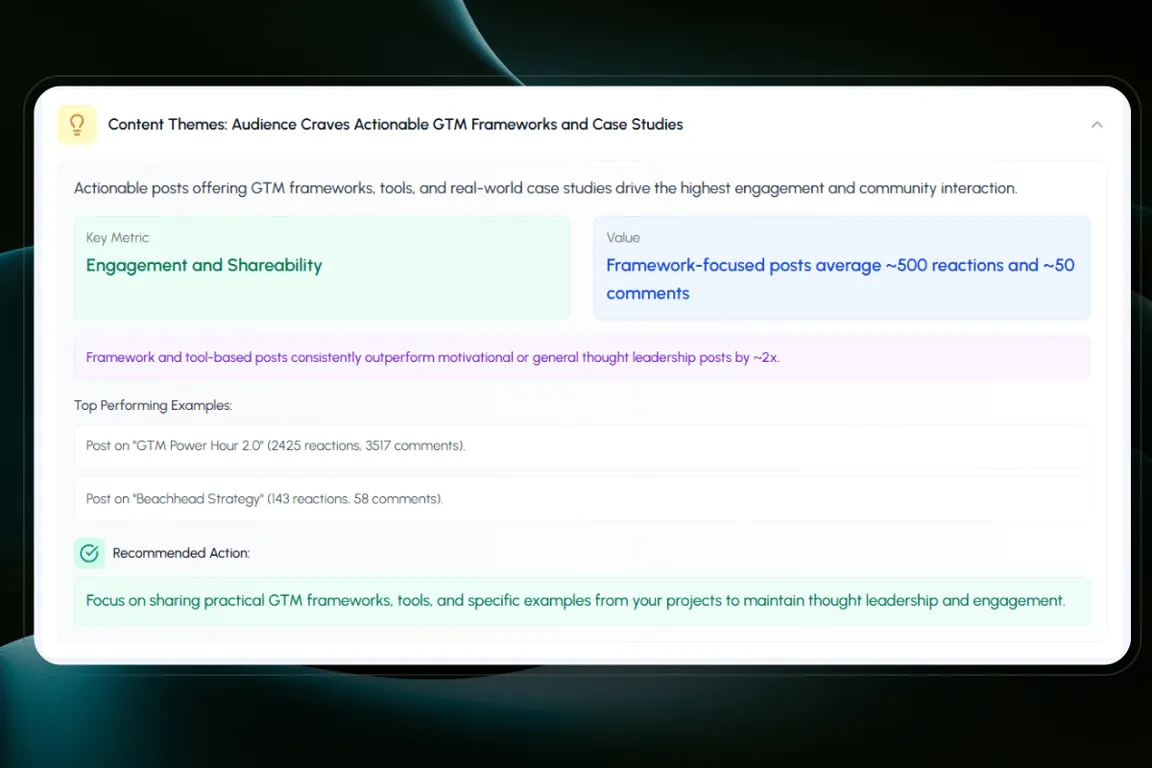
In the next section, we'll dive deep into timing analysis and how to use it to maximize your content's impact on potential clients. But first, look at your last month's posts. Are you getting engagement from your ideal clients, or just general LinkedIn users?
Time and Consistency Analysis
Most advice about posting times on LinkedIn reads like horoscopes.
"Post at 9 AM on Tuesday for maximum engagement!"
"Wednesday mornings are the best time to reach decision-makers!"
The reality? Your ideal posting time depends entirely on your target clients' behavior patterns. Let's look at how to find your actual optimal posting windows.
Understanding Time-Based Engagement
LinkedIn's feed algorithm isn't chronological, but timing still matters. Here's why:
When you post matters less than when your target audience is actively engaging on LinkedIn. A post at 3 PM that catches your ideal clients during their afternoon coffee break beats a 9 AM post that gets buried under morning updates.
LiGo Analytics tracks this by showing you not just when you post, but when you get meaningful engagement from key accounts. The difference can be striking.
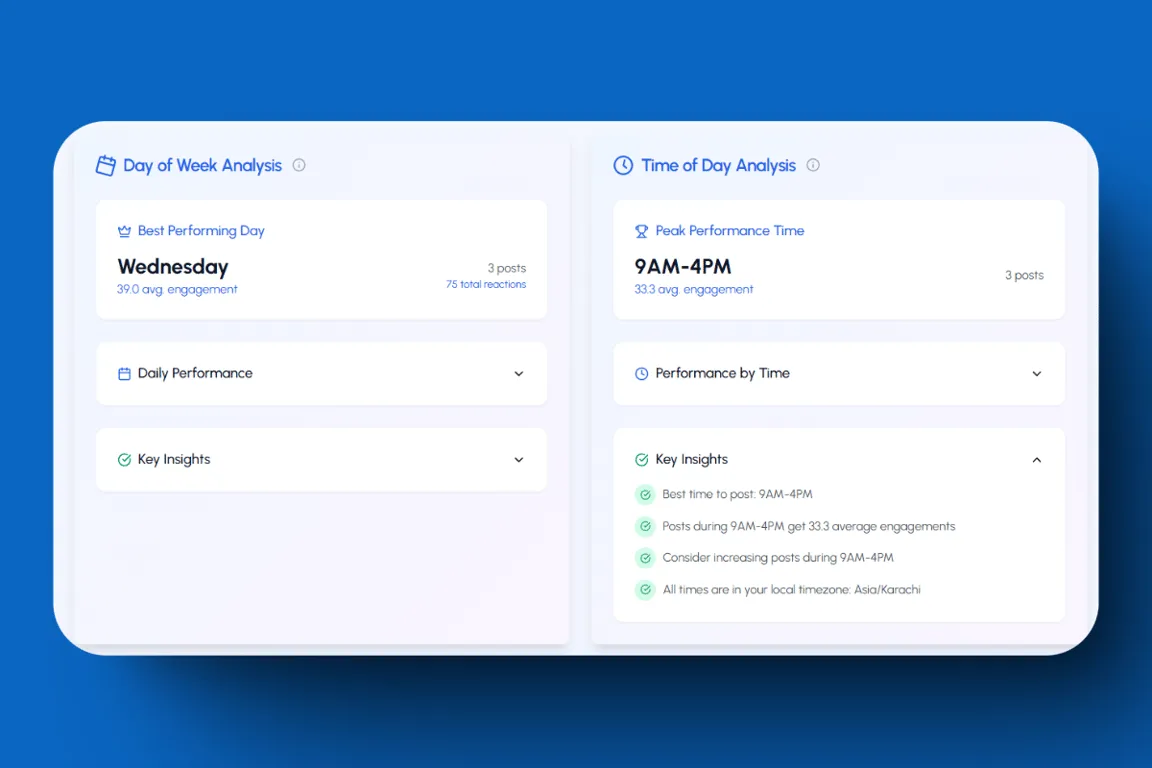
Take this example: An agency targeting UK-based fintech companies was posting at 9 AM GMT based on "best practices." When they analyzed their engagement data, they discovered their highest-quality comments came between 4-6 PM – when fintech CTOs were winding down their day and catching up on LinkedIn.
The Consistency Paradox
Everyone talks about consistency on LinkedIn. But there's a catch:
Predictable timing ≠ Better results
What matters is being consistently visible when your audience is receptive. This requires understanding three key metrics:
-
Engagement Windows
-
When do your posts get meaningful comments (not just likes)?
-
Which time slots show higher engagement from decision-makers?
-
Are there patterns in when your content gets shared?
-
-
Response Timing
-
How quickly do you respond to comments?
-
What's the typical time gap between post and first high-intent comment?
-
When do conversation threads tend to die out?
-
-
Audience Activity Cycles
-
Do your target clients engage more on certain days?
-
Are there seasonal patterns in engagement?
-
How do industry events affect engagement timing?
-
Discover your optimal posting windows with LiGo.
Building Strategic Momentum
The real power of timing analysis isn't about finding the "perfect" posting time. It's about building momentum through strategic timing decisions.
Here's what this looks like in practice:
-
Start with a baseline posting schedule
-
Track engagement quality by time slot
-
Adjust based on high-intent engagement patterns
-
Test and refine over 4-6 weeks
LiGo's analytics dashboard makes this process seamless by automatically identifying your highest-performing time slots based on meaningful engagement, not just raw numbers.
Content Performance Analysis
"Which types of posts work best on LinkedIn?"
This is the wrong question.
The right question is: "Which types of posts attract the right kind of engagement from my target clients?"
Let's break down content performance analysis into metrics that actually matter for client acquisition.
Length vs. Value Correlation
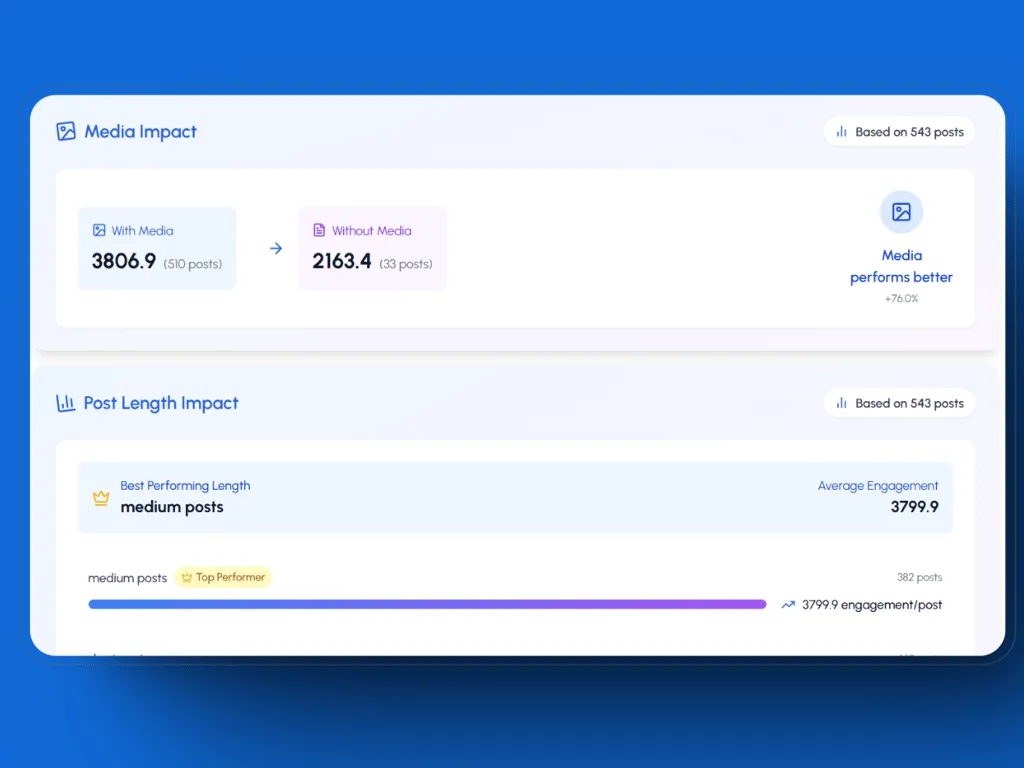
The data from thousands of B2B service providers' posts shows an interesting pattern:
Short posts (< 100 words)
-
High general engagement
-
Low client-intent signals
-
Rarely drive meaningful conversations
Medium posts (100-300 words)
-
Balanced engagement
-
Good for establishing expertise
-
Often trigger specific questions
Long posts (300+ words)
-
Lower overall engagement
-
Higher quality comments
-
Better at qualifying potential clients
But these numbers alone don't tell the whole story. What matters is how different content lengths serve different strategic purposes.
Topic Resonance Mapping
Instead of just tracking which topics get the most engagement, track which topics attract the right kind of engagement. Here's how:
-
Map your content themes:
-
Technical deep-dives
-
Process explanations
-
Client success stories
-
Industry insights
-
Behind-the-scenes
-
-
Track engagement quality by theme:
-
Which topics generate client inquiries?
-
What content sparks technical discussions?
-
Which posts get shared by decision-makers?
-
-
Analyze content-client fit:
-
Do technical posts attract technical buyers?
-
Are process posts reaching operations leaders?
-
Which content types qualify leads best?
-
LiGo helps you track these patterns automatically, showing you exactly which content themes resonate with your target audience.
The Media Impact Factor
Adding images or videos to your posts isn't always better. Here's what the data actually shows:
Text-only posts
-
Often perform better for technical topics
-
Generate more thoughtful comments
-
Work well for nuanced discussions
Posts with visuals
-
Get more initial attention
-
Work better for process explanations
-
Effective for brand building
The key is matching your media strategy to your content goals. A complex technical insight might perform better as a text-only post, while a client success story might need visual elements to maximize impact.
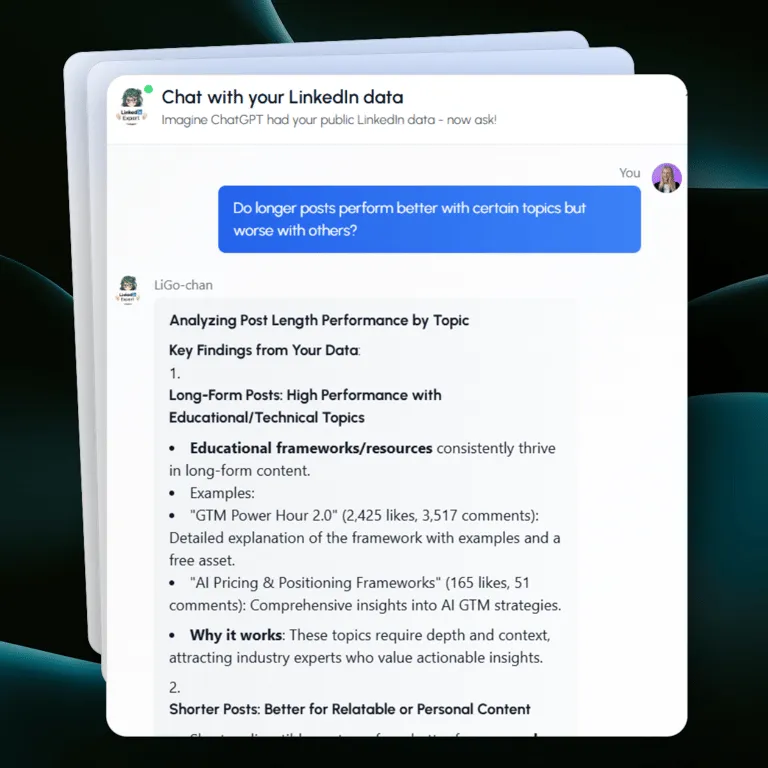
Understanding these patterns helps you create content that not only engages but converts. In the next section, we'll explore how to turn these insights into a sustainable client acquisition strategy.
But first, look at your highest-performing posts from the past month. Are they actually your best posts, or just the ones that got the most reactions?
Network Growth and Client Acquisition
Let's talk about the most misunderstood metric on LinkedIn: follower growth.
An agency owner recently told me: "I gained 2,000 followers last month!"
"Great," I said. "How many were potential clients?"
Silence.
This is where most LinkedIn strategies fall apart. Growing your network isn't about accumulating followers – it's about attracting the right ones.
Audience Quality Over Quantity
Here's what actually matters in network growth:
-
Industry Alignment
-
Are new followers from your target industries?
-
What positions do they hold?
-
Do they engage with content related to your services?
-
-
Engagement Progression
-
Do new followers become active engagers?
-
How quickly do they move from likes to comments?
-
Are they sharing your content with their network?
-
-
Connection Quality
-
Are you attracting decision-makers?
-
Do new connections lead to meaningful conversations?
-
What's the ratio of potential clients to general followers?
-
The Client Acquisition Funnel
Think of your LinkedIn presence as a qualification funnel:
Followers → Engagers → Commenters → Prospects → Clients
Each stage should filter for intent. Here's what to track:
-
Follower to Engager Conversion
-
What percentage of new followers engage with your content?
-
Which posts convert followers to engagers?
-
How long does this conversion typically take?
-
-
Engager to Commenter Evolution
-
What triggers the shift from likes to comments?
-
Which topics generate meaningful discussions?
-
How many touchpoints before meaningful interaction?
-
-
Commenter to Prospect Transition
-
What patterns precede direct messages?
-
Which content series convert best?
-
What's your qualification rate?
-
LiGo Analytics helps you track these progressions, showing you exactly how followers move through your funnel.
Advanced Analytics Strategies
This is where it gets interesting. Let's move beyond basic metrics to intelligence that actually drives business decisions.
AI-Powered Pattern Recognition
LiGo's AI analytics engine does something unique: it looks for patterns in your engagement data that humans might miss. Here's what it analyzes:
-
Engagement Sequences
-
What content combinations lead to client inquiries?
-
Which posting patterns maximize meaningful engagement?
-
How do different content types work together?
-
-
Comment Sentiment Analysis
-
What's the intent behind comments?
-
How does sentiment evolve over time?
-
Which topics generate positive client sentiment?
-
-
Predictive Indicators
-
Early signs of client interest
-
Content themes likely to resonate
-
Optimal timing for follow-up content
-
Creating Content Strategy From Data
Here's where the rubber meets the road. Use your analytics to build a content strategy that actually drives client acquisition:
-
Content Mix Optimization: Start with what your data tells you:
-
Which topics generate client inquiries?
-
What content types qualify leads best?
-
What's the ideal balance of technical vs. business content?
-
-
Engagement Pattern Replication: Look for successful patterns:
-
What content sequences drive conversations?
-
Which post structures generate meaningful comments?
-
How can you systematize what works?
-
-
Strategic Timing : Use your timing data to:
-
Plan content around peak engagement periods
-
Time follow-up content for maximum impact
-
Schedule based on client activity patterns
-
The Feedback Loop
The real power of analytics comes from creating a continuous improvement cycle:
-
Post content
-
Analyze engagement
-
Identify patterns
-
Adjust strategy
-
Repeat
LiGo's AI helps automate this process, providing real-time insights you can act on immediately.
Get AI-powered content strategy insights with LiGo.
Chat With Your LinkedIn Data
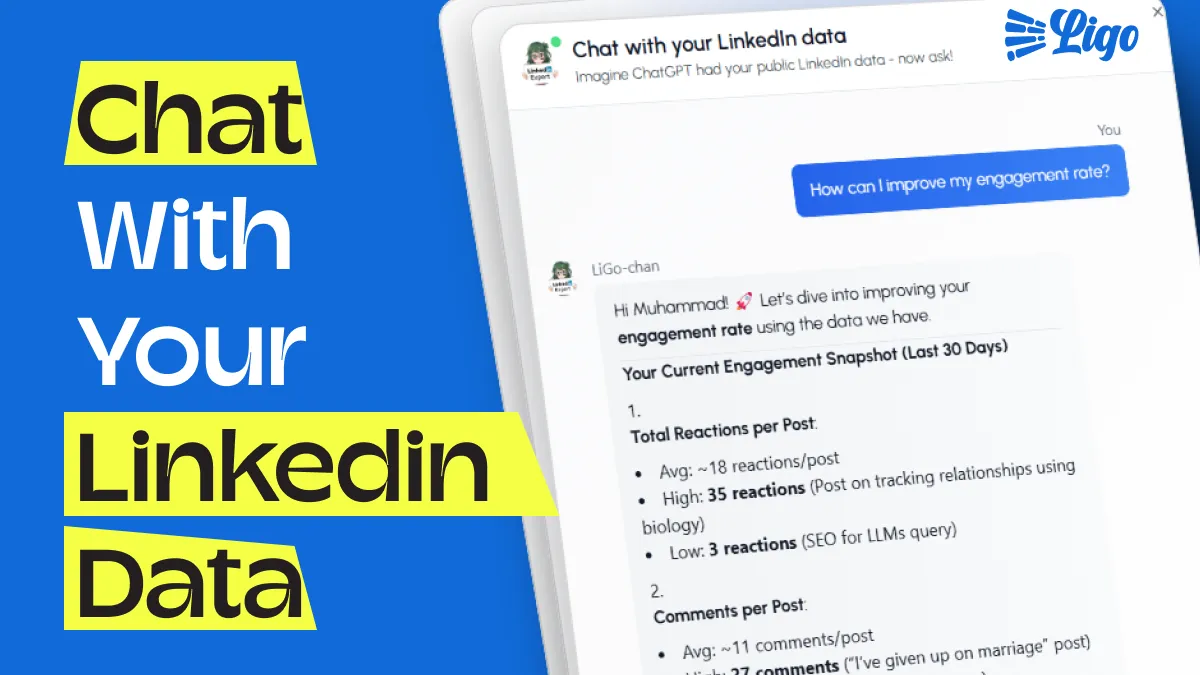
This is where LiGo really stands out. Our AI consultant feature (we call her LiGo-chan) lets you have a conversation with your LinkedIn data.
A quick but important note: LiGo can only analyze public data – your posts, comments, and engagement patterns. We can't track private messages or profile views. This means when we talk about "client inquiries," we're specifically looking at public interactions like comments asking about your services.
However, this limitation actually helps keep your strategy focused on generating public discussions, which often lead to better client relationships anyway. Plus, you can always enhance LiGo-chan's analysis by telling her about your DM conversions and client acquisition patterns. She'll incorporate this context into her recommendations.
Ask LiGo-chan questions like:
-
"Which posts generated the most service-related questions in comments?"
-
"What's the common thread in content that drives technical discussions?"
-
"How can I improve engagement from my target audience?"
-
"Here's a post that led to three client projects - what patterns do you see in it?"
The AI analyzes your data along with any additional context you provide, giving you specific, actionable recommendations.
Measuring What Matters
"You can't improve what you don't measure."
But you also can't measure everything. And you shouldn't try to.
Instead of drowning in metrics, let's build a simple but effective measurement system that actually helps you get more clients.
The Mini Analytics Stack
Here's what a practical LinkedIn measurement system looks like for service providers:
-
Weekly Health Metrics
-
Ratio of target audience comments to total comments
-
Number of technical/service-specific questions received
-
Engagement from previous clients and prospects
-
-
Monthly Growth Patterns
-
Evolution of comment quality (are you getting more specific questions?)
-
Topic performance trends (which subjects generate client interest?)
-
New potential client engagement (first-time meaningful interactions)
-
-
Quarterly Business Impact
-
Content themes that consistently generate client discussions
-
Network growth in your target industries
-
Engagement-to-conversation pipeline efficiency
-
LiGo tracks these automatically, but you can start with a simple spreadsheet if you prefer.
Building Your Conversion Framework
Since we can't track private messages directly, you'll want to build a reliable conversion tracking system. Here's how:
-
Public Interaction Tracking
-
Tag comments that indicate buying intent
-
Monitor progression from general questions to specific inquiries
-
Track which content series generate service-related discussions
-
-
CRM Integration: Consider using a LinkedIn-friendly CRM like Folk or Breakcold to:
-
Automatically capture LinkedIn conversations
-
Track prospect progression from first comment to client
-
Map content touchpoints in the client journey
-
Monitor response rates and conversation outcomes
These tools can help you connect the dots between your public LinkedIn engagement and private conversations.
-
-
Unified Tracking System: Combine LiGo's analytics with your CRM data:
-
Match public engagement patterns with conversion data
-
Identify which content themes drive meaningful conversations
-
Track the full journey from comment to client
-
Document which engagement patterns indicate serious prospects
-
-
Feed These Insights Back: Share this context with LiGo-chan to enhance your analytics:
-
"This post led to three client projects"
-
"Comments about X topic often lead to DM inquiries"
-
"These engagement patterns typically indicate serious prospects"
-
The key is connecting your public engagement data with your actual client conversations. A good CRM will help you do this systematically, while LiGo helps you optimize the content that starts these conversations.
Build your conversion tracking system with LiGo.
Action Plan: Next Steps
Let's turn all this analysis into action. Here's your roadmap for the next 30 days:
Week 1: Audit & Baseline
-
Export your last 90 days of posts
-
Tag comments indicating client interest
-
Note which posts generated meaningful discussions
-
Set up your basic tracking system
Week 2: Pattern Recognition
-
Identify your top-performing content themes
-
Map out your best engagement times
-
List your most engaged potential clients
-
Start tracking new metrics
Week 3: Content Adjustment
-
Adjust your posting schedule based on data
-
Focus on topics that attract client comments
-
Replicate patterns from successful posts
-
Begin testing new content types
Week 4: System Refinement
-
Review and adjust your tracking system
-
Document what's working and what isn't
-
Set up regular review intervals
-
Plan your next 90 days of content
Quick Wins You Can Implement Today
-
Clean Up Your Analytics
-
Remove vanity metrics from your tracking
-
Focus on engagement quality over quantity
-
Start tagging high-intent comments
-
-
Optimize Your Current Process
-
Post when your target audience is active
-
Respond to high-intent comments first
-
Double down on topics that generate client discussions
-
-
Enhance Your Strategy
-
Use LiGo's AI to analyze your best-performing content
-
Create content series around successful themes
-
Build on patterns that drive meaningful engagement
-
The goal isn't to become an analytics expert. The goal is to use data to get more clients with less effort.
You don't need perfect data. You need actionable insights that help you make better decisions about your LinkedIn content.
Start small. Focus on what matters. Adjust as you learn.
And most importantly, keep posting. No analytics system in the world will help if you're not consistently creating content that resonates with your target clients.
Need help making sense of your LinkedIn analytics? LiGo-chan is ready to help you decode your data and build a strategy that actually works for your business.
Common Pitfalls and Solutions
Let's address the real challenges you'll face when implementing analytics-driven LinkedIn strategy. More importantly, let's talk about how to overcome them.
The Perfectionism Trap
A software agency owner recently told me: "I spent three weeks building the perfect analytics dashboard. Now I'm too busy maintaining it to actually create content."
Sound familiar?
The solution isn't more metrics. It's better focus.
Start with tracking just three things:
-
Comments from potential clients
-
Topics that generate technical discussions
-
Content themes that lead to service-related questions
Everything else can wait.
The Consistency vs. Quality Balance
"Should I post more frequently or focus on better content?"
This is a false choice. Here's why:
Good content posted regularly beats perfect content posted rarely. But there's a catch – "good" means "valuable to your target clients," not "polished until it shines."
The real balance is between:
-
Content that demonstrates expertise
-
Content that starts conversations
-
Content that qualifies prospects
LiGo helps you maintain this balance by suggesting content ideas that align with your successful patterns.
The Algorithm Obsession
The LinkedIn algorithm changes constantly. Your target clients' needs don't.
Instead of chasing algorithm updates, focus on:
-
Creating content your ideal clients want to engage with
-
Building genuine conversations in your niche
-
Maintaining visibility in your target market
The algorithm rewards content that generates meaningful engagement. Focus on that, and algorithm changes become less relevant.
Authenticity vs. Optimization
"If I focus too much on analytics, won't my content feel artificial?"
This concern comes from misunderstanding what analytics are for. The goal isn't to create robotic, optimized content. It's to understand what resonates with your audience so you can serve them better.
Use analytics to:
-
Identify topics your audience cares about
-
Understand when they're most receptive
-
Learn which formats drive meaningful discussions
Then create content in your voice about those things.
The Scale Trap
As your LinkedIn presence grows, you'll face pressure to scale your content operation. This often leads to:
-
Outsourcing to writers who don't understand your expertise
-
Creating generic content to meet posting quotas
-
Losing the personal touch that attracted clients
Instead, use analytics to scale smartly:
-
Identify your highest-impact content types
-
Focus on topics that consistently drive client discussions
-
Use tools like LiGo to maintain quality while saving time
The Next Steps
Look at your LinkedIn strategy right now. Are you:
-
Tracking metrics that actually matter for client acquisition?
-
Creating content that generates meaningful discussions?
-
Building a system you can maintain long-term?
If not, start small:
-
Pick one metric that directly relates to client acquisition
-
Track it for two weeks
-
Adjust your content based on what you learn
-
Add more metrics only when needed
To reiterate: The goal isn't to become a LinkedIn analytics expert. The goal is to get more clients through LinkedIn with less effort.
LiGo can help you do this by:
-
Focusing on metrics that matter
-
Identifying patterns that drive results
-
Suggesting content that resonates with your target audience
-
Helping you maintain consistency without sacrificing quality
The best LinkedIn strategy is the one you can sustain while growing your business. Start there.




